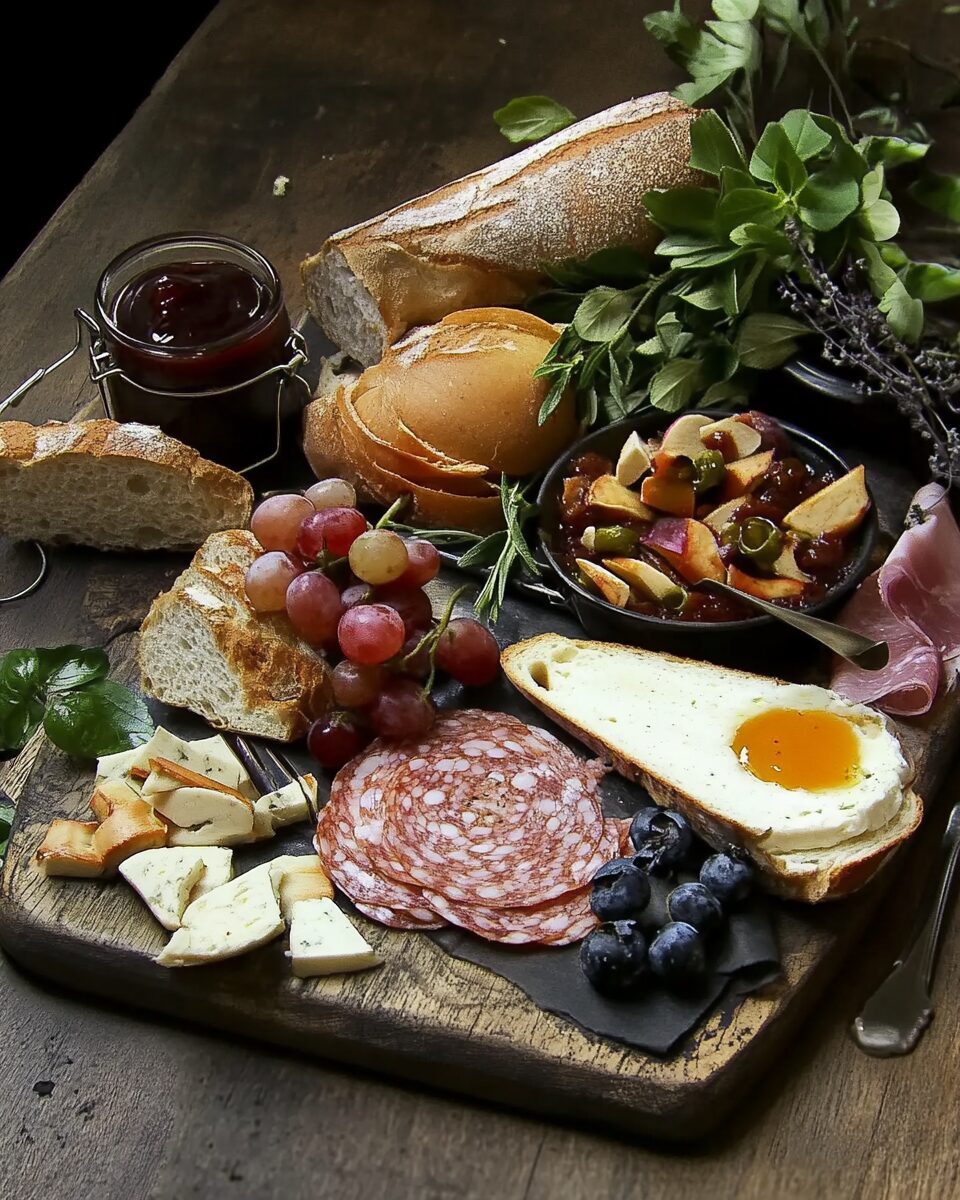The Ploughman’s Lunch is a hearty and rustic British meal, traditionally served in pubs. It’s a no-fuss spread of flavorful English Cheddar, thick slices of Baked Virginia Ham, crisp apples, radishes, and freshly baked bread. This dish is perfect for a casual gathering or a simple yet satisfying lunch.
The beauty of the Ploughman’s Lunch lies in its simplicity and adaptability. You can serve it as a light appetizer for a party or as a complete meal for the family. The variety of textures—from the crunch of the vegetables to the softness of the hard-boiled eggs—paired with the savory ham and sharp Cheddar make it a crowd-pleasing option for any occasion.
Full Recipe:
- Fig or lemon leaves, for decoration
- Chunk of good English Cheddar
- Jar of Chutney
- Baked Virginia Ham, thickly sliced (recipe below)
- Crisp apples, cut up
- Celery stalks with leaves, cut in half lengthwise
- Bunch radish, sliced in half
- Soft Hard-Boiled Eggs (recipe below)
- Baby carrots
- Loaf of crusty bread, thickly sliced
- Unsalted butter, softened
Directions:
- Decoratively arrange the fig or lemon leaves on a serving platter or cutting board.
- Carefully place the remaining ingredients on top of the leaves, arranging them in an appealing manner.
- Serve the platter with thick slices of crusty bread and softened butter.
Baked Virginia Ham:
- Preheat the oven to 350°F (175°C).
- Place a 14- to 16-pound fully cooked, spiral-cut smoked ham on the bone in a roasting pan.
- In a food processor, mince 6 garlic cloves, 8 1/2 ounces mango chutney, 1/2 cup Dijon mustard, 1 cup packed light brown sugar, the zest of 1 orange, and 1/4 cup freshly squeezed orange juice until smooth.
- Pour the glaze over the ham and bake for 1 hour, until heated through and the glaze is browned.
- Serve hot or at room temperature.
Soft Hard-Boiled Eggs:
- Place 6 extra-large eggs in a large saucepan and cover with cool water.
- Bring the water to a boil, reduce heat, and simmer for 3 minutes.
- Transfer the eggs to a bowl of cold water until cool, peel, slice, and season with salt and pepper.
Prep Time: 10 minutes | Cooking Time: 3 minutes | Total Time: 13 minutes
Kcal: 450 kcal (approx.) | Servings: Varies depending on party size
The Ploughman’s Lunch: A Quintessential British Tradition
The Ploughman’s Lunch is a simple yet hearty meal that has stood the test of time, maintaining its status as one of Britain’s most iconic dishes. Traditionally served in pubs, this rustic platter of cold, fresh ingredients encapsulates the heart of rural English cuisine. Whether served in an upscale restaurant or enjoyed at home, the Ploughman’s Lunch is a meal that brings together a delightful array of flavors, textures, and cultural heritage.
Historical Background
The origins of the Ploughman’s Lunch trace back to the British countryside, where farmers (ploughmen) would pack a simple midday meal to sustain them during long hours of labor in the fields. It is said that the meal was designed to be easy to carry, requiring no refrigeration or cooking while providing enough nutrition to keep the ploughman going throughout the day.
While its origins are deeply rooted in agricultural life, the term “Ploughman’s Lunch” was popularized in the 1950s and 1960s by a marketing campaign run by the Milk Marketing Board in the UK. Their aim was to promote the sale of British cheese, and they cleverly tied the concept to this humble yet satisfying meal. The Ploughman’s Lunch became synonymous with pub food, and to this day, it remains a popular choice for both locals and tourists visiting British taverns.
Key Components of a Traditional Ploughman’s Lunch
The Ploughman’s Lunch is celebrated for its simplicity, yet each element plays a critical role in the overall experience of the meal. Here are the key components typically found on a traditional Ploughman’s platter:
- Cheese: A chunk of sharp English Cheddar is the star of the platter. Some versions also feature Stilton, Red Leicester, or other regional British cheeses.
- Meat: While some versions of the Ploughman’s Lunch are vegetarian, many include slices of ham, typically Baked Virginia Ham or Wiltshire-cured ham.
- Bread: Thick slices of crusty bread, often served with butter, add a hearty base to the meal.
- Pickles and Chutney: Branston pickle or chutney is a must-have, offering a tangy contrast to the rich cheese and ham.
- Fresh Vegetables and Fruit: Crisp apples, radishes, celery, and baby carrots bring freshness and crunch to the platter.
- Eggs: Soft-boiled eggs (or hard-boiled) are often included for an additional protein boost.
- Other Additions: Some variations also include pickled onions, lettuce, tomatoes, or even Scotch eggs.
Why the Ploughman’s Lunch is So Beloved
There are several reasons why the Ploughman’s Lunch has remained a staple in British cuisine and why it has found popularity outside the UK as well:
- Simplicity and Accessibility: The beauty of the Ploughman’s Lunch lies in its simplicity. It doesn’t require any elaborate cooking techniques or hard-to-find ingredients. In fact, many of the ingredients are pantry staples or items that are readily available at most supermarkets.
- Versatility: The Ploughman’s Lunch is highly adaptable to personal preferences and dietary restrictions. Vegetarians can easily enjoy a meat-free version, and those looking to add more protein can include additional meats like roast beef or sausage. Vegan versions can substitute dairy-free cheese and plant-based spreads.
- Balance of Flavors and Textures: Each element of the meal brings a different flavor and texture to the table. The sharpness of the cheese, the saltiness of the ham, the sweetness of the apples, and the crunch of the radishes all create a harmonious balance that makes every bite interesting.
- Nostalgia: For many, the Ploughman’s Lunch is a comforting reminder of simpler times, whether it’s childhood memories of pub lunches or the association with traditional English rural life.
- Perfect for Sharing: The Ploughman’s Lunch is often served as a large platter, making it a great option for sharing among family or friends. It’s ideal for picnics, casual gatherings, or even as a light meal at home.
Modern Takes and Variations
While the traditional Ploughman’s Lunch is beloved in its classic form, modern versions have introduced new ingredients and creative twists to cater to contemporary tastes and dietary needs. Some popular variations include:
- Artisan Cheeses and Cured Meats: Instead of the classic Cheddar, some versions feature artisanal cheeses like Brie, Gouda, or goat cheese. In terms of meats, salami, prosciutto, or even smoked salmon are sometimes included for a more gourmet touch.
- Gourmet Chutneys and Pickles: Rather than the standard Branston pickle, foodies might enjoy chutneys made from exotic fruits like mango or fig, or pickles that have been fermented with a variety of spices.
- Gluten-Free and Vegan Options: Many restaurants and home cooks offer gluten-free bread or crackers as an alternative to the traditional loaf. Vegan versions often feature plant-based cheeses and spreads made from cashews or soy.
- Seasonal Variations: Depending on the time of year, the fruits and vegetables in a Ploughman’s Lunch can change to reflect what’s in season. In the autumn, apples and pears are popular, while summer versions might feature tomatoes, cucumbers, and fresh herbs.
Serving and Presentation Tips
One of the defining characteristics of the Ploughman’s Lunch is its rustic and visually appealing presentation. Here are a few tips for serving this dish:
- Use a Wooden Board: A large wooden serving board adds to the rustic feel of the meal and allows for easy sharing.
- Layering for Aesthetic Appeal: Arrange the ingredients in clusters to make the platter visually appealing. Place the cheese and meat at the center, surrounded by bread, vegetables, and fruits.
- Garnishing with Leaves: Fig or lemon leaves are often used as a decorative element on the platter. You can also use lettuce or kale for a similar effect.
- Serve with Ale or Beer: Traditionally, the Ploughman’s Lunch is enjoyed with a pint of ale or beer, further enhancing the pub experience. For a non-alcoholic option, a crisp apple cider works well too.
Health Benefits of a Ploughman’s Lunch
Despite being a simple dish, the Ploughman’s Lunch offers several nutritional benefits, making it a healthy choice for a balanced meal:
- Rich in Protein: With cheese, eggs, and ham as the primary components, this meal provides a good source of protein, which is essential for muscle repair and energy.
- High in Fiber: The inclusion of fresh fruits and vegetables, as well as whole-grain bread, ensures that the meal is high in fiber, aiding digestion and promoting a feeling of fullness.
- Variety of Nutrients: The range of ingredients means you’re getting a variety of vitamins and minerals, including calcium from the cheese, vitamin C from the fruits and veggies, and iron from the eggs and ham.
Conclusion
The Ploughman’s Lunch is more than just a meal—it’s a celebration of British culture and the simple pleasures of wholesome, fresh ingredients. Whether you’re enjoying it in the comfort of your home, packing it for a picnic, or ordering it at a traditional pub, the Ploughman’s Lunch is a dish that never disappoints. Its versatility and adaptability make it perfect for a wide range of occasions, from casual family lunches to gatherings with friends.
By embracing modern variations, you can also customize this classic dish to suit your dietary preferences or to add a contemporary twist. Ultimately, the Ploughman’s Lunch is a timeless meal that brings together the best of British cuisine while offering a balance of flavors, textures, and nutrition.






